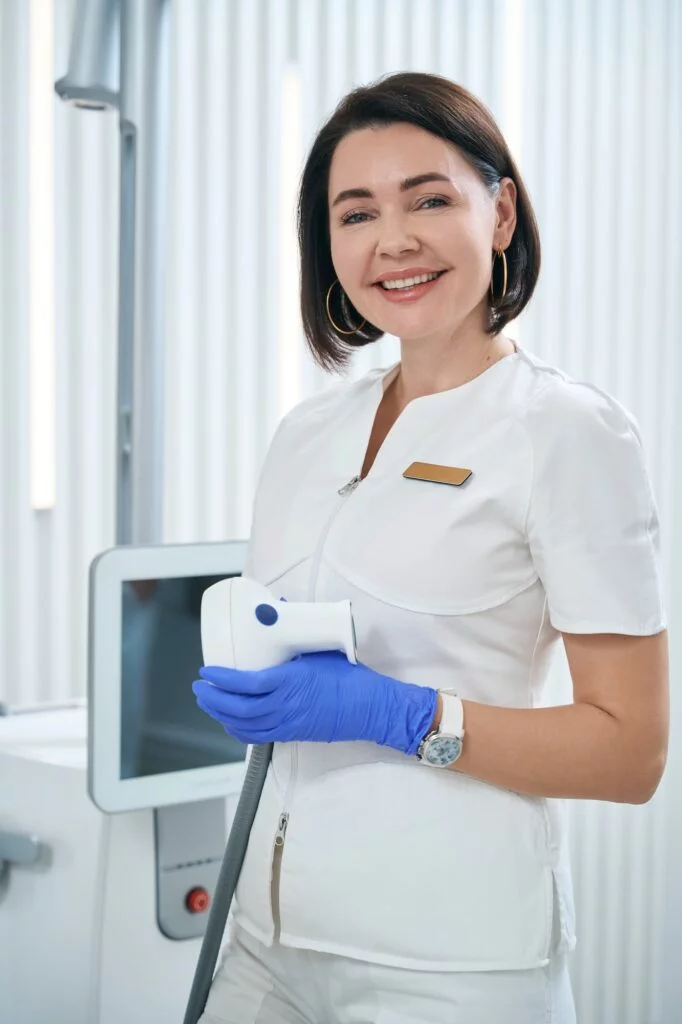YOUR INITIAL CONSULTATION: COME PREPARED!
You will save a lot of time if you come to your appointments fully prepared with all the required information and pre-filled forms. Please visit frequently asked questions and link to several related resources for more information regarding treatment and patient support.
What to Bring:
- Your initial radiation therapy consultation will require some preparation on your part. You will need to bring:
- Health insurance card with your policy number and name of policy holder (spouse or other family member whose name is on the insurance policy), and policy-holder’s social security number.
- A picture ID preferably a valid drivers license or a state issued picture identification card.
- Referral authorization letter, if you are in an HMO or PPO.
- Referring physician’s name, address and phone number. The names and telephone numbers of all other physicians currently involved in your care including that of your primary care physician.
- List of medications you currently take (including over-the-counter medicines). Please include the strength and dose of each medication.
- Patient Initial Consultation Forms. We encourage you to download and print out the Patient Information Form. Please fill out as much as you can and feel free to call our offices with any questions you may have.
What Not to Bring:
- Valuable items such as jewelry or watches. During the examination and treatment, you will have to remove them, and we cannot be responsible for these valuables. Feel free to call our offices with any questions you may have.
- Large amounts of cash.
BEFORE TREATMENT – HOW TO PREPARE FOR YOUR SIMULATION
Follow the instructions provided by your health care provider. You may have a CT scan or PET scan before the session to map the exact spot of the cancer.
Please arrive 15 minutes early on the day of your appointment. It will give you adequate time to familiarize with the department and to change into a gown. You will then wait in one of our waiting areas until the radiation therapist arrives to escort you to the simulation suite.
Treatment simulation session
Before your radiation therapy begins, your treatment team carefully plans the details with a treatment simulation session. This is a meeting with you, your radiation oncologist and other members of the radiation team. Usually, your treatment planning will involve taking detailed images of your body and making precise marks in the areas that will receive the radiation beams. The team will also plan your body position on the table so that only a minimal amount of healthy tissue will be in the path of the radiation. This process will help you feel comfortable and give you an opportunity to ask any questions about your radiation treatment.
Positioning
First, the team will determine how you will be positioned on the table to optimize your treatment. It is important to find a comfortable position that you can hold for 15 – 30 minutes. You will have to be able to lie still. If the position is uncomfortable of awkward, an immobilizing device may used to hold you in place and give extra support. Measurements may be taken of prominent bones to be used as reference points.
Immobilizing devices
To ensure that you will remain in position the entire treatment, an immobilizer may be created to prevent any movement during your therapy. If you are receiving radiation to your brain, head or neck, a mask may be made from firm plastic and molded to your face. This is a quick and painless process. During your treatment, the mask will be secured to the table and will gently hold your head in place. For body treatments, a Vac-Loc bag (a medical body beanbag) will be molded to hold and cradle your body in optimal position.
The purpose of these devices is to make you feel as comfortable as possible during the 15 – 30 minutes of your treatment. It is also extremely important to hold your position, without movement, to minimize the amount of healthy tissue within the radiation beam path.
Marking
A radiation therapist may mark your body to indicate the precise spot for your treatment. The type of markings used will depend on your tumor and the type of treatment that you will receive. Some marks can be made by a marking pen and are not permanent. Others marks are permanent tattoos, the size of a freckle, that cannot be rubbed off or washed away during the course of your treatment. Please discuss any concerns about receiving these tattoos with your radiation therapy team.
Treatment planning
Once you have finished the preliminary set-up for your treatment, your part of the treatment planning process is finished. Be sure that you ask your treatment team all the questions that you have, including:
- How long will each treatment last?
- How often will I have to have treatment?
- How many weeks will I have to have therapy?
- Can I drive myself home?
- What should I expect if I’m having chemotherapy and radiation at the same time?
- What side effects could I have? When do they start?
- How long will it take before we see the results of the radiation?
In the next few days, a medical physicist, or dosimeters, will work with the radiation oncologist to find the best way to direct the radiation at your cancer using state-of-the-art computers.
After simulation
After your simulation, you will be given an appointment card with the time and date of your first appointment for treatment. Your appointment time will usually be the same throughout your course of treatment (examples: Daily at 2:15 pm or daily at 10:45 am). Routine treatments are scheduled from Monday through Friday on a daily basis between 8:00 am and 4:30 pm, except for holidays.
THE TREATMENT PROCESS
The linear accelerator is a very large machine that is used to deliver very precise radiation. It will rotate around you to deliver the radiation dose to your tumor from multiple angles.
As the treatment begins, you will lie on a table. The radiation therapist will align your body to ensure proper administration of the therapy. Then, the table will raise you up under the linear accelerator. Your therapist will step outside the room to monitor your treatment via closed circuit television. You can communicate by using the intercom system.
The linear accelerator will make a buzzing sound while the radiation is being delivered, but you will not feel or see it. It is extremely important that you do not move during your treatment.
Your condition will be assessed weekly while receiving treatment to see how your body is responding to the treatment. The nurse will answer any questions that you have. Follow all instructions carefully, and report any unusual symptoms to your radiation therapy team.
Follow-up care
Follow-up appointments are an important means of measuring the continuing effects of your radiation and may include blood work and X-rays. It is extremely important to schedule and keep regular appointments after your therapy.
Important things to remember
- Wear comfortable clothes for treatment because you may have change into a gown.
- If you must see your radiation oncologist on a day other than your regularly scheduled day, please let your nurse or therapist know. They will help you arrange a different time for the physician meeting.
- It is essential that you do not skip any treatments or other clinic appointments. Therefore, if you must reschedule your appointment, please call us as soon as possible. (One day advance notice is helpful.)
- Your therapist or patient care coordinator will advise you of any schedule changes due to major holidays.
- Maintaining a healthy lifestyle is also a part of your treatment once your radiation therapy is complete.
AFTER TREATMENT
The linear accelerator is a very large machine that is used to deliver very precise radiation. It will rotate around you to deliver the radiation dose to your tumor from multiple angles.
- The treatment area may be washed, but only with a mild soap as Dove or Ivory. Gently pat the area dry with a soft towel; do not rub hard. Skin marks should be carefully preserved and not washed unless instructed to do so. You will receive permanent tattoos that are small and freckle-like. These will not wash away.
- Itching and redness are normal skin reactions to radiation therapy. We recommend the use of pure (98% – 100%) aloe vera gel for ‘sunburn’ type reddened skin reactions. Apply liberally 3-4 times a day. Do not apply within the two hours prior to your treatment. Aloe vera gel is soothing and can help your skin prior to the actual skin reaction. You may use it at the commencement of treatments. If your skin breaks down and becomes moist during the treatment, your physician or nurse will consult with you and recommend skin care.
- The treatment area should be protected from the sun during the course of treatment. Use of sunscreen is acceptable. Hats, visors and high collars are encouraged it if will help protect the treated area.
- The treatment area should receive no form of heat from hot water bottles, heating pads or jacuzzis.
- No cosmetics, creams, lotions or powders should be applied to the treatment area unless you are instructed. Any recommended preparations should be applied after your treatment.
- A good daily diet is essential. Consult with your therapist or nurse if eating is difficult.
- Open or safety razors should not be used on the treated area. Use of an electric razor is allowed. If the underarm is being treated we recommend not shaving at all and the only deodorant used should be cornstarch or baking soda.
- Avoid tight clothing which might rub the treated area. (bras, straps, tight collars, girdles)
- If anything related to your treatment is worrying you please notify your therapist or nurse.
- Your weight will be checked weekly to help monitor your progress and tolerance to the treatments.
- Your physician will see you periodically while you are receiving treatment. If your physician is not available and you have a problem, one of her/his associates will be available to see you.
- If you are receiving treatment to the mouth or throat, this area might become sore. Gargling with a solution of 1 qt. water, 1 tsp. Salt, 1 tsp. baking soda every 3 hours while awake will offer some relief. Your physician may make additional individualized recommendations depending on the severity of the reaction.
- Follow-up visits are important and will be arranged at the completion of your treatments.



